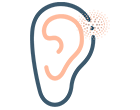Pingault, V., Ente, D., Dastot-Le Moal, F., Goossens, M., Marlin, S., & Bondurand, N. (2010). Review and update of mutations causing Waardenburg syndrome. Human mutation, 31(4), 391–406. https://doi.org/10.1002/humu.21211
Saleem M. D. (2019). Biology of human melanocyte development, Piebaldism, and Waardenburg syndrome. Pediatric dermatology, 36(1), 72–84. https://doi.org/10.1111/pde.13713
Ren, S., Chen, X., Kong, X., Chen, Y., Wu, Q., Jiao, Z., & Shi, H. (2020). Identification of six novel variants in Waardenburg syndrome type II by next‐generation sequencing. Molecular Genetics & Genomic Medicine, 8(3). doi: 10.1002/mgg3.1128
Read, A. P., & Newton, V. E. (1997). Waardenburg syndrome. Journal of medical genetics, 34(8), 656–665. https://doi.org/10.1136/jmg.34.8.656
Tagra, S., Talwar, A. K., Walia, R. L., & Sidhu, P. (2006). Waardenburg syndrome. Indian journal of dermatology, venereology and leprology, 72(4), 326. https://doi.org/10.4103/0378-6323.26718
Ringer J. (2019). Identification of Waardenburg Syndrome and the Management of Hearing Loss and Associated Sequelae: A Review for the Pediatric Nurse Practitioner. Journal of pediatric health care : official publication of National Association of Pediatric Nurse Associates & Practitioners, 33(6), 694–701. https://doi.org/10.1016/j.pedhc.2019.06.001
Minami, S. B., Nara, K., Mutai, H., Morimoto, N., Sakamoto, H., Takiguchi, T., Kaga, K., & Matsunaga, T. (2019). A clinical and genetic study of 16 Japanese families with Waardenburg syndrome. Gene, 704, 86–90. https://doi.org/10.1016/j.gene.2019.04.023





